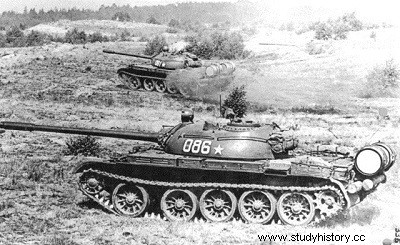
t
Type:main battle tank.
Crew:4 men.
Armament:one 100 mm gun; a 7.62 mm SGMT machine gun paired with the main armament; a 7.62 mm SGMT machine gun in the bow; a DShK 12.7 mm anti-aircraft machine gun.
Armour:maximum 170 m.
Dimensions :
length (including armament):9 m;
length (hull):6.45 m;
width:3 .27 m;
height (without anti-aircraft armament):2.40 m.
Weight in combat order:36 t
Ground pressure:0.81 kg/cm2.
Engine:Model V-54 12 cyl. air-cooled diesel, developing 527 hp at 2,000 rpm.
Performance:
maximum road speed:48 km/h;
autonomy:400 km;
vertical obstacle:0.80 m;
clear cut:2.70 m;
slope:60%.
Service time:
introduced into the Soviet army in 1950. Also used by AfghaniStan, Albania, Algeria, East Germany, Angola, Bangladesh, Bulgaria, People's China, Cyprus, North Korea, Cuba, Egypt, Finland, Hungary, India, Iraq, Israel, Libya, Morocco, Mongolia, PLO, Uganda, Pakistan, Peru, Poland, Romania, Somalia, Sudan, Syria, Czechoslovakia, Vietnam, North Yemen, South Yemen Yugoslavia. (Note:Data is for the T-45).
The first prototype of the T-54, completed in 1947, was a logical development of the T-44 tank, created towards the end of the Second World War. The latter itself was derived from the T-34, which many consider to be the best medium tank of the war. The T-54 was also built in China, under the name of T-59, as well as in Czechoslovakia and Poland. Although we do not have precise figures on this subject, it is estimated that the total production of the T-54 and T-55 of all models was 60 to 70,000 copies.
The hull of the T-54 is an all wrought steel assembly and its turret is cast, except for the upper part, which is welded into place. The driver is at the front right of the hull and the three other crew members are in the turret:commander and gunner on the left, loader on the right. There are two hatches. Engine and transmission are at the rear, separated from the combat chamber by a bulkhead. The suspension has five road wheels on each side, with the sprocket at the front and the idler wheel at the rear. There are no support rollers, the tracks resting directly on the road wheels. This suspension is torsion bar, that is to say of a proven type. The main armament is a 100 nm D-10T rifled cannon firing APHE, HEAT or HE shells. Its firing in elevation is from -17° to -4°, which constitutes a weak point if compared to western tanks. A coaxial 7.62 mm SGMT machine gun is paired with the main armament; a similar weapon, mounted in the front of the hull, is served by the driver. A DShK 12.7mm anti-aircraft machine gun is mounted on the loader hatch. The ammunition load is 34 100 mm shells, 500 12.7 mm cartridges and 3,000 7.62 mm cartridges. Most T-54 and T-55 tanks have full infrared night vision equipment, including driving lights, a searchlight for the commander, and another searchlight to the right of the gun. Additional fuel tanks can be installed at the rear of the hull to increase the range of the tank. It can also emit its own smoke screen in the same way as the PT-76, by injecting vaporized diesel fuel into the exhaust system on either side of the tank. The vehicle can ford up to powerful (588 hp), an increased ammunition load for 1 gun (43 shells) and a fully standard main armament. bilized. It had no anti-aircraft machine gun, but later most T-55s had one. The T-55A followed in 1963:it had no bow machine gun and the coaxial 7.62 mm SGMT machine gun was replaced by a PKT machine gun.
The T-54/T -55 base has been assigned to many:tasks. At least four armored recovery vehicles are known:the T-54-T, T-54A ARV, T-54B ARV and T-54ct
ARV. The most widespread model is the T-54-T, equipped with a spade at the rear, a platform for transporting tank spare parts and a jib crane. A snorkel can be mounted for crossing deep fords. Two basic models of mine-clearing tanks are in service:one of the "plow" type and the other of the "roller" type, of which there are various variants. More recently the Russians have developed a demining system similar to the British "Giant Viper":an explosive cable, thrown into the minefield, is set on fire, and with a little luck, blows up the mines . Three types of bridge layers are in service. The MTU-54/MTU-55 was the first to appear, it carries a 12.30m long bridge. The M1967 has a bridge, the ends of which are raised when the vehicle is in motion. Deployed, this bridge bridges a gap up to 20 m wide. The Czechs created a model called MT-55, carrying a scissor-shaped bridge that allows crossing a 17m wide ditch.
Elements of the T-54 are also used in the anti-aircraft tank has twin 57 mm guns ZSU-57-2, in the ATS-59 crawler tractor and in the PTS amphibious. Further tank refinements resulted in the T-62 main battle tank.
The T-54, used in combat by North Vietnam, Pakistan, India, Egypt, Syria, Iraq, Angola, Algeria, Libya and Somalia, has proven reliable on the battlefields. Much easier to use than comparable Western vehicles, it is however outclassed by tanks such as the Leopard and M60.
